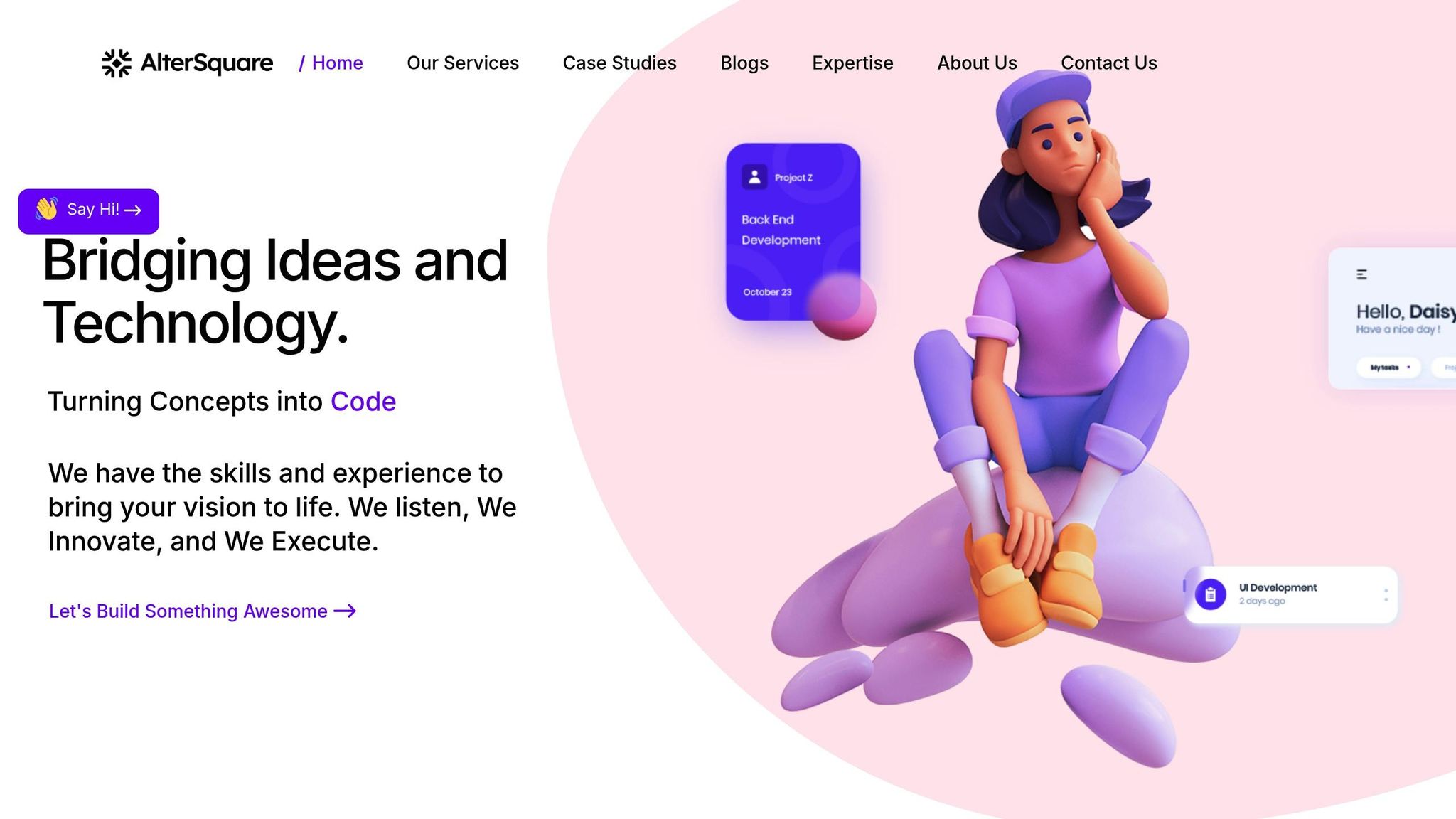Skipping scalability in MVP development might save time and money upfront, but it can lead to massive costs later. Startups often face delayed launches, expensive rebuilds, and lost revenue when their MVPs can’t handle growth. Here’s what you need to know:
- Short-term savings can lead to long-term losses: Ignoring scalability can increase future costs by 15–25% due to technical debt, infrastructure upgrades, and compliance issues.
- Rebuilds are costly: Fixing scalability issues later can cost 2–3x the original MVP budget, with expenses ranging from $50,000 to $250,000 or more.
- Delays hurt growth: Scalability problems can slow down market entry, causing missed revenue opportunities and higher customer churn.
- Smart planning pays off: Spending 10–20% more upfront on scalable architecture can cut future rebuild costs by 50%.
The solution? Build with scalability in mind from day one. Use modular systems, reliable tech stacks (e.g., Node.js, GoLang, AWS), and strong QA/security practices. Investing in scalability early saves money, time, and headaches down the road.
Why Does Rushed MVP Development Lead To Technical Debt For Startups? – Founders Supporting Founders
Hidden Costs of Ignoring Scalability
Skipping scalability planning might seem like a cost-saving decision at first, but the true financial impact often sneaks up later. These hidden costs tend to surface as your MVP gains traction, catching founders off guard. In fact, early decisions to cut corners can increase long-term ownership costs by as much as 15–25% [6].
Take the example of a fintech startup that opted for a monolithic architecture to save time and money during its MVP phase. As the user base grew, the system became sluggish and unresponsive, forcing a costly shift to a microservices and cloud-based infrastructure. This migration not only drained resources but also caused delays in development and lost revenue opportunities [6]. On the other hand, companies that invested in scalability from the outset avoided these challenges [6]. The first signs of these hidden costs often appear in your technical architecture.
Technical Architecture and Tech Debt
Rushed decisions in your technical architecture can pile up technical debt, leading to expensive rewrites and modernizations down the road [1][2]. When speed trumps structure, every shortcut taken becomes a potential liability later.
Over time, the costs of addressing technical debt can grow exponentially. Core modules might need complete overhauls, databases may require migrations, and integrations can fail, all of which slow down the development of new features. With each architectural compromise, the complexity of maintenance increases, turning quick fixes into prolonged headaches. Instead of taking days to roll out new features, teams could find themselves bogged down for weeks.
"We build it right the first time. Unlike freelancers or offshore factories, every line of code is architected for scale. No costly rewrites when you hit growth milestones – just seamless scaling."
– AlterSquare [1]
Infrastructure and DevOps Costs
An infrastructure that lacks scalability can quickly become a financial sinkhole as your user base grows. What starts as manageable hosting costs can balloon when the system struggles to handle increased demand. To keep things running, you may need to invest heavily in cloud upgrades, additional bandwidth, storage, and advanced monitoring tools [5].
But the costs don’t stop there. Manual scaling efforts can pull DevOps teams away from strategic growth tasks, slowing down deployment cycles [3]. Even short periods of downtime can lead to revenue losses and damage customer trust – problems that only grow as your business scales. Beyond operational expenses, scalability issues can also lead to heightened regulatory risks.
Data Compliance and Security Risks
As your business grows, poor scalability in data management can turn compliance into a major headache [3]. Systems built for small-scale operations often struggle to meet evolving regulations like GDPR or CCPA when managing larger volumes of sensitive data. Without proper data governance, your business could face hefty regulatory fines [3].
Security is another area where scalability gaps can become dangerous. Risks that might seem manageable with a small dataset can snowball into major vulnerabilities when handling thousands of records. Data breaches become more likely and more damaging, leading to direct costs like fines and indirect ones like legal fees, customer churn, and reputational harm [3]. Retrofitting compliance measures – such as encryption, audit trails, and user consent management – often requires significant architectural changes, which can derail your product roadmap.
Financial Impact: Rebuilds, Delays, and Lost Revenue
The financial toll of ignoring scalability becomes glaringly obvious once your MVP starts gaining traction. What might have seemed like a smart way to cut costs during development can quickly spiral into a budgetary disaster, threatening your entire business. Here’s a hard truth: rebuilds caused by scalability issues can end up costing 2–3 times the original MVP development budget. And that’s before you even factor in lost revenue and missed opportunities during periods of downtime [5][8].
The Cost of Emergency Rebuilds
When your system collapses under growing demand, emergency rebuilds are often unavoidable. These unplanned overhauls can range anywhere from $50,000 to $250,000 – or even more – depending on the complexity of your product, the size of your user base, and how quickly fixes are needed [3][4]. The costs stack up fast because you’re essentially paying a premium for urgent intervention.
For starters, hiring skilled developers on short notice drives up expenses. Senior developers, who are often needed for such tasks, command higher rates, and you’ll likely be paying overtime or contractor premiums. Meanwhile, your existing team gets pulled away from working on new features, slowing down your overall progress.
Then there’s the challenge of data migration. Moving user data, transaction histories, and configurations is a meticulous process. Any errors can lead to data loss, legal troubles, or unhappy customers.
On top of that, downtime during these rebuilds has its own price. Every hour your system is offline or underperforming means missed revenue and frustrated users. For SaaS startups, this downtime can directly hit monthly recurring revenue. These unexpected costs don’t just inflate your budget – they also delay your ability to launch or scale effectively.
Delays in Market Entry
Scalability problems don’t just drain your budget – they also slow down your entry into the market. When performance bottlenecks force you to postpone your product launch, the consequences ripple far beyond just your development timeline.
Revenue opportunities slip through your fingers as you scramble to fix foundational issues. For SaaS startups, even a single month of delay can mean losing anywhere from $10,000 to $100,000 in recurring revenue, depending on your pricing model and market size [2][4]. And it’s not just revenue at stake – delays can shake investor confidence. Missed milestones make it harder to secure funding, as investors may start questioning your ability to execute.
There’s also the risk of losing the first-mover advantage. In competitive markets, being late to launch often means higher customer acquisition costs down the line, as competitors grab market share while you’re stuck fixing scalability issues.
Lost Customers and Revenue
The fallout from delays and rebuilds doesn’t stop at your budget – it also impacts your customers. When scalability issues lead to poor system performance, the user experience takes a hit, and customer losses follow. These aren’t just one-time costs; they can have a lasting impact on your revenue potential.
Users expect fast, reliable service. When your system struggles under load, they’re met with slow response times, frequent outages, and inconsistent performance. This leads to higher churn rates – studies show that persistent performance problems can increase churn by 20–30% [7]. Every customer lost isn’t just immediate revenue gone – it’s also the loss of their lifetime value.
Replacing churned customers comes with its own challenges. Negative reviews and word-of-mouth about your product’s performance can make acquiring new users more expensive and difficult. Over time, this compounds the damage, making it even harder to recover and grow.
sbb-itb-51b9a02
How to Build Scalable MVPs
Creating a scalable MVP is all about making smart, forward-thinking decisions that save you from expensive rebuilds down the road. The challenge lies in balancing speed to market with a solid foundation for future growth. Here’s how to tackle it effectively.
Choosing the Right Tech Stack
Picking the right tech stack is one of the most impactful decisions in MVP development. A poor choice can lead to a complete overhaul within 18 months, with over 60% of MVPs failing to scale as a result [9][3].
Start with proven, scalable technologies. Options like Node.js, GoLang, Python, React, and Vue.js are excellent choices because they support growth seamlessly. These tools also come with extensive documentation, active developer communities, and a history of scaling successfully.
For infrastructure, cloud-native platforms such as AWS, Azure, or Google Cloud are ideal. Their pay-as-you-go models allow you to start small and scale automatically as your needs grow.
Choose technologies with long-term maintainability in mind. Instead of chasing trends, rely on seasoned engineers to guide these decisions, ensuring your tech stack supports seamless integration and future growth.
Once your tech stack is in place, focus on designing your infrastructure to handle shifts in demand with ease.
Building Modular Infrastructure
A modular architecture is key to flexibility and scalability. By designing your system as independent, modular components, you can scale specific parts of your application based on real-world demand. This approach avoids the rigid structures that often lead to costly rebuilds.
Starting with a modular monolith is a practical first step. It allows you to enjoy the benefits of modular design without the initial complexity of managing multiple services. When certain components face scaling challenges, you can extract them into separate services without overhauling your entire application.
Clearly defined API boundaries make it easier to update or scale individual modules independently. This also simplifies onboarding for new developers, as they can focus on specific modules instead of navigating the entire codebase.
Using tools like Docker for containerization adds another layer of flexibility. Containers make it easy to deploy and scale your application across different environments while optimizing resource use. Additionally, planning your database design early – especially for data separation – ensures that as your application grows, related data can be migrated without major disruptions.
A modular system not only scales more efficiently but also simplifies testing for quality and security.
Quality Assurance and Security Planning
Scalability is just one part of the equation; robust QA and security practices are essential for building a reliable MVP. Automated testing – covering unit, integration, and load tests – should be part of your development process from the start. These tests simulate user growth scenarios, helping you identify and address issues early.
Performance testing under simulated loads can uncover bottlenecks before they impact users. Continuous integration and deployment (CI/CD) pipelines make it easier to roll out updates and fixes, which becomes increasingly important as your system scales.
Security should also be a priority from day one. Implement secure authentication, data encryption, and strong access controls early to avoid expensive retrofits later. Additionally, plan for compliance with regulations like GDPR and CCPA to ensure your system is prepared for long-term operation.
Integrating real-time monitoring, logging, and analytics from the beginning allows you to catch issues early and focus your scaling efforts where they’re needed most. This proactive approach to observability helps optimize performance based on actual usage patterns. By investing in QA and security upfront, you can avoid prolonged disruptions and maintain customer trust [9].
The AlterSquare Approach to Scalable MVPs

Creating a scalable MVP isn’t just about having a solid idea – it requires a well-thought-out plan that prioritizes scalability at every step. AlterSquare’s methodology stands out by embedding scalability into the entire development process, ensuring long-term growth while avoiding hidden costs. Let’s break down how their approach combines structured processes, real-world success stories, and AI tools to make scalable MVPs a reality.
Structured Delivery Framework
AlterSquare’s five-phase framework – from discovery to post-launch support – lays the groundwork for building MVPs that grow effortlessly with user demand. It starts with the discovery and strategy phase, which pinpoints market fit and scalability needs early on. By addressing these factors upfront, businesses can avoid expensive retrofitting down the road.
The design and validation phase focuses on creating a user-friendly, modular architecture that supports future growth. This step tackles common scalability problems, like rigid system designs that can’t handle increased traffic, reducing the risk of costly rebuilds later.
During agile development, AlterSquare’s "Zero Technical Debt Guarantee" ensures every piece of code is designed with scalability in mind. This eliminates the need for expensive rewrites as demand grows. The launch preparation phase includes detailed infrastructure planning to anticipate growth scenarios, while post-launch support ensures ongoing optimization and performance monitoring. Together, these steps make scalability a continuous priority, not just an afterthought.
AlterSquare also leverages cutting-edge technologies like Vue.js, Nuxt.js, GoLang, and Node.js. These tools are specifically chosen for their ability to support modular designs, integrate seamlessly with cloud platforms, and manage resources efficiently – all of which are essential for scaling MVPs as user bases expand. This structured approach is backed by real-world examples that showcase the benefits of planning for scalability from the outset.
Case Studies and Results
AlterSquare’s success stories highlight the importance of prioritizing scalability from the very beginning. The company has stepped in to rescue startups struggling with performance issues and technical debt caused by poor early-stage architectural decisions.
In one example, AlterSquare helped a company transition from a rigid, non-scalable system to a modular architecture. The result? Improved revenue and higher user satisfaction. In another case, a startup under tight market deadlines used AlterSquare’s rapid prototyping and tech-stack consultation to launch on time, avoiding delays often linked to scalability problems. Clients have even described AlterSquare as "godsent" during these critical moments.
These examples underline a key takeaway: planning for scalability from day one saves startups from expensive emergency rebuilds. By addressing scalability during MVP development, AlterSquare’s clients avoid the common pitfalls of launching quickly only to face massive reconstruction costs later.
Using AI and Generative AI Tools
AlterSquare takes scalability to the next level by integrating advanced AI tools into its development process. These tools streamline MVP creation while maintaining scalability standards, making the entire process faster and more efficient.
For example, automated code generation and predictive analytics help forecast user growth and determine system requirements. Generative AI analyzes usage patterns and suggests optimal resource allocation, creating flexible architectures that adapt as user demands change. This reduces the manual effort typically required for scalability planning.
The company’s 90-day MVP program leverages these AI tools to accelerate development and reduce costs, benefiting both technical and non-technical founders. AI-powered rapid prototyping allows teams to test scalability assumptions early, catching potential bottlenecks before they become costly problems.
Post-launch, AI tools continue to play a vital role. Automated performance monitoring and analytics identify scaling opportunities and potential issues before they impact users. This proactive approach not only keeps systems running smoothly but also minimizes long-term operational expenses.
Conclusion: Scalability as a Long-Term Investment
When building an MVP, scalability is more than a technical detail – it’s a strategic decision that can make or break your startup’s future. The numbers back this up: startups that prioritize scalable architectures from the start often see up to 50% faster time-to-market and save 30–40% on long-term development costs compared to those forced into costly post-launch overhauls[3][4].
Yes, incorporating features like API versioning, rate limiting, and service isolation may add 2–3 weeks and $8,000–$12,000 to your initial MVP budget. But that upfront effort can save you months of downtime and lost customers when it’s time to scale[9]. Skipping these steps often leads to disastrous consequences – many startups face complete product rebuilds within their first year, draining early-stage funding and stalling momentum[9]. It’s a choice between proactive planning and reactive scrambling.
Shortcuts come with steep hidden costs. Ignoring scalability creates technical debt, which grows alongside user adoption. What starts as a small performance issue can snowball into major system failures, driving users away. Data shows that startups often spend more on patching post-launch problems in their first year than they did on the initial development itself when scalability wasn’t prioritized[9].
The long-term benefits of scalable MVP planning are undeniable. While a non-scalable MVP might save money upfront, it often results in higher ongoing expenses and limits growth potential. On the other hand, investing in modular architectures may require a slightly higher initial cost but delivers lower long-term expenses and enables smoother growth. This frees up resources for innovation and feature development instead of constant firefighting, giving startups a stronger position in the market.
For founders weighing their options, the choice is straightforward when viewed through the lens of sustainable growth. Those who prioritize scalable MVPs and partner with experienced teams set themselves up for success. They avoid the pitfalls of mounting technical debt and emergency fixes, allowing them to scale confidently while others struggle to keep up.
So, the real question isn’t whether you can afford to invest in scalability during MVP development. It’s whether you can afford not to. Scalability isn’t just an expense – it’s the foundation for long-term growth and success.
FAQs
Why should scalability be a priority when developing an MVP?
Scalability is a crucial consideration when developing your MVP. Why? Because it ensures your product can grow alongside your business without requiring expensive and time-consuming rework down the line. By building with scalability in mind from the very beginning, you can sidestep potential technical limitations, keep future costs in check, and maintain smooth operations as your user base expands.
A scalable design means your MVP is ready to handle rising user demands, integrate new features, and adapt to shifts in the market. Taking this forward-thinking approach not only saves you valuable time and resources but also positions your product for long-term growth and stability.
What are the risks and long-term costs of not prioritizing scalability during MVP development?
When building an MVP, ignoring scalability can create serious headaches down the road. Think about it: as your product gains traction, you’ll face expensive system upgrades, sluggish performance under heavy traffic, and frustrated users who might abandon your platform altogether.
However, tackling scalability early on can prevent these issues. By designing your MVP with growth in mind, you set the stage for smooth expansion. Partnering with skilled teams specializing in MVP development and product engineering can make a huge difference. They’ll help you address scalability upfront, saving you time, money, and countless future headaches.
How can startups quickly develop an MVP while ensuring it’s scalable for future growth?
Startups often face the challenge of balancing rapid development with the need for scalability. The solution? Starting with a well-thought-out technical foundation. By doing so, your MVP (Minimum Viable Product) is better equipped to support future growth without requiring expensive overhauls down the road.
This is where experienced partners like AlterSquare come in. Their 90-day MVP program blends fast prototyping with expert guidance on choosing the right tech stack. The result? Scalable, market-ready products built efficiently. This method not only speeds up development but also minimizes the risks and costs tied to scaling as your business grows.









Leave a Reply